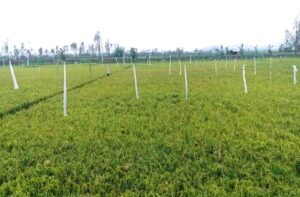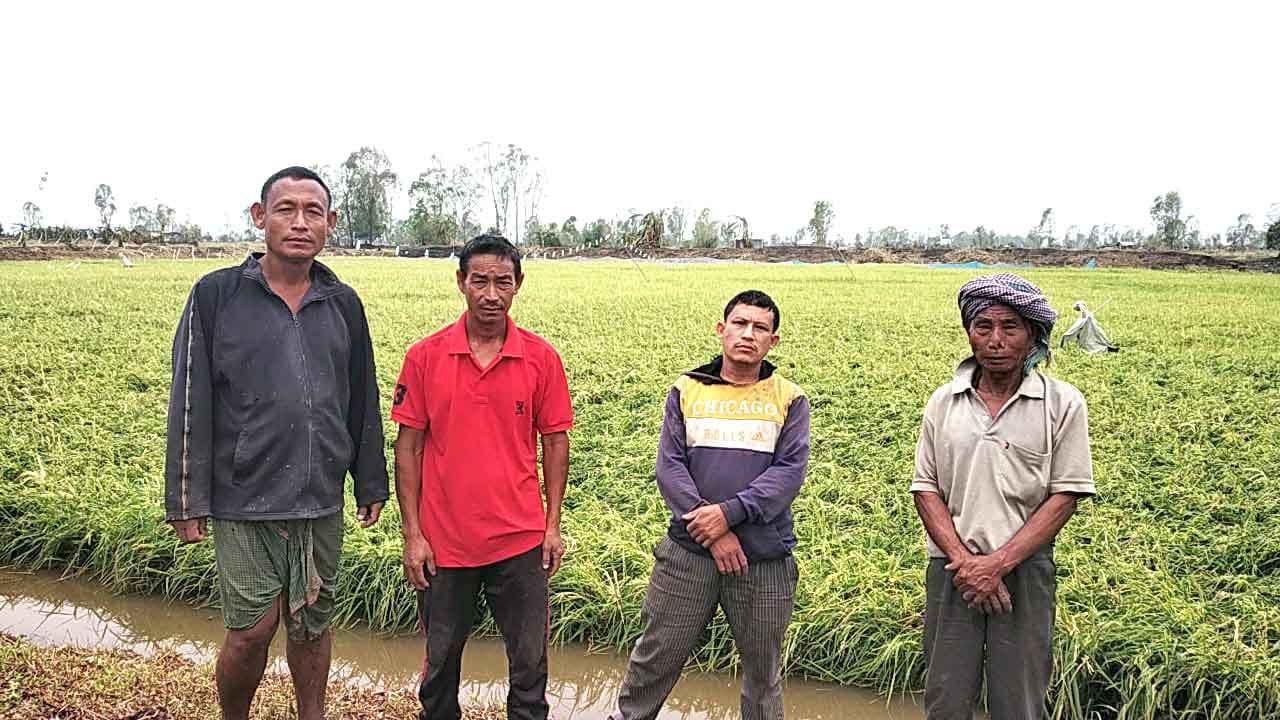“All my dreams have washed away by the hail storms”. I cried a lot in my heart by seeing the entire devastated scene lamented by Ningombam Ratan Singh, 51 years, from Thoubal Ningombam, Ikop Pat in Thoubal District. Mr. Ratan narrated that the ‘5th MAY’ 2024 hailstorm had destroyed all his paddy plants. So far, he had invested Rs. (50-60) thousand for planting the paddy saplings. He remains all his time at his paddy field looking after his damaged paddy plants. He has been planting first crop, SEVA variety which was planted in the month of February and to be harvested in the month of June/July. He chose the hybrid variety SEVA as it is high yielding and short duration. In the previous years he had good harvest from his two Pari (5 Acres) area of paddy field. The paddy plants are almost 110 days old when the hailstorms destroyed his paddy field. He calculated the value of his lost as around Rs. 2.5 Lakh. He also narrated that after the harvest, he rears fishes in the paddy field the previous years. The rising temperature is favourable for plantation of first crop in his paddy field as the place is a wetland area, but the event of hail-storming has devastated all his expectations, he narrated.
The recent Remal cyclone and hailstorm have had a devastating impact in Manipur, causing widespread damage to infrastructure, agriculture, and livelihoods. Strong winds and heavy rainfall led to the destruction of homes and public buildings, displacing many residents and creating urgent humanitarian needs. The hailstorm devastated crops, severely affecting the agricultural sector and leading to economic losses for farmers. The hailstorm dented and destroyed many roofs of the houses. It physically damaged plants, bruising fruits, breaching stems and defoliating plants. It also killed many live stocks. Additionally, the cyclone disrupted transportation and communication network, hampering relief efforts and exacerbating the challenges faced by the affected community.
Another farmer Okram Khomei Meitei, 70 years, from Thoubal Ningombam Utha Leikai expressed in grief that all the crops in his paddy field were all destroyed by the hailstorm. Around 500 fruit bearing banana plants worth Rs. 1 lakh; ekaithabi (Neptuniaoleracea) worth Rs. 50,000; papaya worth around Rs. 30,000; and other seasonal vegetables were also damaged. On that particular day he and his wife Okram Ongbi Dashini were hiding under the blanket and all the roof of his farm house were also damaged. Fishes weighing more than 1 kg and 2 kg started floating in the pond every day. All of their hopes have been vanished by the hailstorms. Who will hear his worries and whom to approach for help? Who will compensate for his great lost?
A farmer who have been practicing farming for the last 20 years Maimom Jarma Singh, 56 years, also lamented that all his reared fishes were dead because of consuming the degraded plants destroyed by hailstorms. He claimed that he had invested around Rs. 60 thousands for rearing the fishes. He estimated the lost by the hailstorm worth of Rs. 2 lakhs. Apart from the fishes all the paddy plants, seasonal vegetables such as pumpkin, chilli, beans, ridged gourd etc. were all damaged by the hailstorm that occurred on 5th May this year which lasted for few hours. It will again take another some months to plant the vegetables and get ready to sell in the market. He questioned himself how to manage his family without any income for some months.

Leimapokpam Singhajit from Utham Leirak, Thoubal is another farmer who is a victim of the hailstorm of 5th May. He narrated to IRAP that after a gap of two years, he planted first crop this year in his three Sangam of paddy field. As all of his crops were damaged by the recent hailstorm, he will not try planting first crop next year. He also expressed that he does not have any knowledge about the crop insurance neither he did not join the insurance. Moreover, he cannot visit the concerned office as he remains engaged in his field all the time. He expressed his opinion that because of industrialisation, development, deforestation, and other human anthropogenic activities have contributed negative impact on our environment thus leading to climate change. Narrating his childhood experiences, Singhajit said that in those days the size of the hailstorms were small and he used to collect it and enjoy it putting in the bucket. But the recent hailstorm has created devastation rather any enjoyed that he experienced in his past life.
Many more farmers namely Netrajit, Tomcha and Gojen etc. have also experiencing the same feeling and have lost all their expectations as all their crops were damaged with hailstorm which last for few hours. All their plans were all gone away and worried how to bear their expenses.
Explaining the phenomenon of this extreme weather event, Dr. M. Damudor Singh, Department of Geography, Thoubal College expressed that as the world is changing, climate change is also a continuous and natural phenomenon. Human interventions accelerate the pace of this phenomenon. The recent devastating hailstorm is the result of these changes. Globally, due to global warming the temperature rises and with the rise of temperature, the caring capacity of moisture i.e., humidity also increases. This results in heavy rainfall and high intensity of hailstorm. In earlier times, the temperature was low as compared to recent days. With the low temperature and low humidity, the intensity of cyclone was mild. He opined that mass plantation of trees can reduce the Carbon Dioxide(CO2), content in the atmosphere which will help in minimizing the effect of global warming. This can be a measure to prevent extreme weather events. He appeals the farmers to update themselves with the meteorological data provided by the concerned department regarding rainfall, cyclone, storm, and others.
In this regard, Prof. L. Nabachandra, Head Department of Agronomy, College of Agriculture, Central Agricultural University (CAU), Imphal said that the recent extreme weather event which was witnessed in Manipur is a clear example of climate change. If there is rainfall, there is high intensity of rainfall in the state. Because of its impact, the pattern, intensity and distribution of rainfall has changed drastically as compared to earlier days. The recent hailstorm had damaged mostly summer vegetables, fruits and trees. It has not left a single plant at the places where there was hailstorm due to high intensity. It has indirect impact on fishery, livestock, fodders etc.
The main reason for dead of fishes is due to polluted water which contains organic acid produced by the decayed/rotten plants growing in and around the water bodies damaged by the hailstorm. The organic compound in the water increases the acidicity of the water which is not favourable for fishes. Suggesting about the preventive measures that can be taken up by farmers from the extreme weather events, Prof. Nabachandra advised that farmers should work torely according to the weather prediction/forecast provided by the agrometeorology division of the state. Particularly for nursery plants precautionary measures can be taken up by covering the area with a protective shield like trampoline sheets, timely sowing of seeds, identifying the right varieties of crops, avoidance of delay practices such as plucking of ripe fruits and vegetables before the occurrence of unwanted extreme weather events. The combine effects of the cyclone and hailstorm underscore the vulnerability of the region to extreme weather events and highlight the need for robust disaster preparedness and response strategies.
(The article is filed under the 5th State Level Media Fellowship Programme on Climate Change under the sponsorship of the Directorate of Environment and Climate Change, Government of Manipur)












